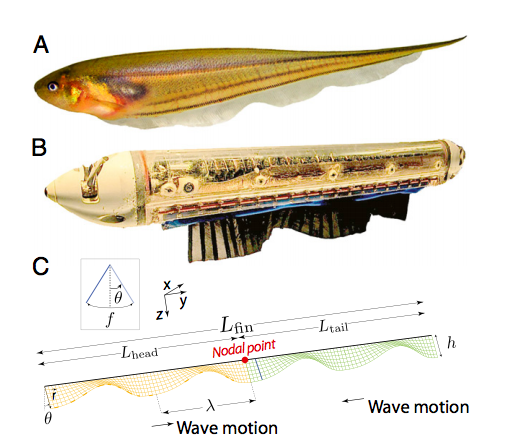Underwater Robots Become Highly Agile; Bio-Inspired Robotics In Electric Fish Research
Professor Malcolm MacIver and his team of researchers from Northwestern University have designed and developed a robotic fish named 'Ghostbot' that has made way for underwater vehicles with high agility. Inspired from the electric electric knifefish found in the Amazonian basis, these multi-disciplinary research group has made an attempt to mimic the omni-directional movement and non-visual sensing techniques of real fishes in their robotic counterpart. The underwater vehicles are used for studying the coral reefs, repairing damaged deep-sea oil rigs or even in investigating the sunken ships.
Electric fish robotics is fast becoming a topic of interest among researchers experimenting with biologically inspired engineering based projects. The underwater vehicles currently in use have huge sizes and lack agility making them of no use to help with work at the manmade structures inside water. The black ghost knifefish came in as a good motivation because of its unique abilities that include hunting at night, ability to sense with a self-generated weak electric field around its entire body (a property we call 'electrosense') and to swim in multiple directions. Using a ribbon-like fin situated in the underside of its body, the fish is able to move both horizontally and vertically.

MacIver and his team from the Northwestern's Neuroscience and Robotics Lab have realized that robotic models of the knifefish will help them better understand details of how the nervous system combines the acquisition of information with movement. In future, by integrating the ribbon fin tech with electro-sense, underwater vehicles will become capable of maneuvering through complex 3-D geometries in murky waters. Take a look at the following video to see the GhostBot in action -
Source: #-Link-Snipped-#
Update: The team's research work for developing the robotic knifefish study has been presented at the annual meeting of the American Association for the Advancement of Sciences (AAAS) annual meeting in Chicago. Those interested in reading about bio-logically inspired robotics, should read about Termite-Inspired robots <a href="https://www.crazyengineers.com/threads/termite-inspired-robotic-construction-crew-is-biologically-inspired-engineering-at-its-best.73334">Termite-Inspired Robotic Construction Crew Is Biologically Inspired Engineering At Its Best</a>.
Electric fish robotics is fast becoming a topic of interest among researchers experimenting with biologically inspired engineering based projects. The underwater vehicles currently in use have huge sizes and lack agility making them of no use to help with work at the manmade structures inside water. The black ghost knifefish came in as a good motivation because of its unique abilities that include hunting at night, ability to sense with a self-generated weak electric field around its entire body (a property we call 'electrosense') and to swim in multiple directions. Using a ribbon-like fin situated in the underside of its body, the fish is able to move both horizontally and vertically.

Update: The team's research work for developing the robotic knifefish study has been presented at the annual meeting of the American Association for the Advancement of Sciences (AAAS) annual meeting in Chicago. Those interested in reading about bio-logically inspired robotics, should read about Termite-Inspired robots <a href="https://www.crazyengineers.com/threads/termite-inspired-robotic-construction-crew-is-biologically-inspired-engineering-at-its-best.73334">Termite-Inspired Robotic Construction Crew Is Biologically Inspired Engineering At Its Best</a>.
0
